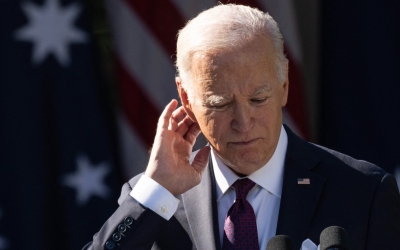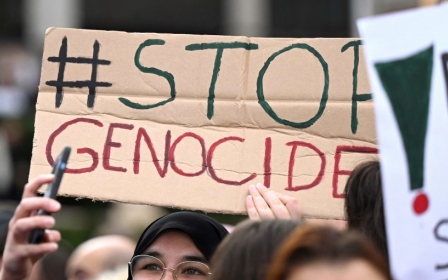Why Hezbollah's low intensity war of attrition may yet pay dividends

Shortly after Israel assassinated Hamas's second-in-command, Saleh al-Arouri, in southern Beirut on 2 January, the Lebanese group Hezbollah issued a brief statement immediately condemning the malicious attack in its backyard.
The following day, Hezbollah leader Hassan Nasrallah delivered an address marking the fourth anniversary of the US government's assassination of Iranian General Qassem Soleimani, who was killed in Baghdad in 2020, the last year of the Trump administration.
For Nasrallah to speak about Arouri's assassination on this particular occasion was significant since Soleimani was the architect of the so-called "axis of resistance" to which Hezbollah and the Palestinian resistance groups, Hamas and Islamic Jihad, belong. Other de facto members include several armed groups in Iraq and Yemen, as well as some Iranian proxies in Syria.
During his speech last Wednesday, Nasrallah pledged revenge and reiterated his group's strategy to continue with measured military engagement across the border with the Zionist state. Two days later, in a follow-up address, he discussed at length what Hezbollah's military campaign against Israel in the last three months had accomplished, including the launching of 670 attacks that resulted in striking 494 significant Israeli targets near the Lebanese border, which included dozens of settlements, military bases, radars and monitoring stations.
Nasrallah further claimed that as many as 230,000 Israeli settlers may have been evacuated from the north away from the border clashes. Unsurprisingly, the military confrontations have caused significant disruptions for those Israeli communities and exerted political and economic pressure on the government.
Since Hamas's retaliatory attack on 7 October, Israel has unleashed an unprecedented annihilation war on Gaza, surpassing all of its previous wars in terms of brutality, cruelty, total disregard for the laws of war, or demonstrating minimum adherence to the Geneva or international conventions.
So far, Israeli forces have killed more than 23,000 Palestinians - with thousands more still missing - and injured and maimed approximately 60,000 others, and continue to systematically destroy every aspect of life in order to make Gaza uninhabitable.
The massive devastation prompted South Africa to file last week a detailed case of genocide against the Israeli government before the International Court of Justice (ICJ) at the Hague. While the result of this case may be a political game changer in the near future, Nasrallah insisted in his speech that only brute force would compel Israel to halt its ferocious assault on Gaza.
From the start of its campaign on 8 October, Hezbollah defined its role in the Gaza conflict as supportive of the Palestinian resistance and engaged militarily in a war of attrition against the Israeli army.
Military strategy
On 3 November, Nasrallah gave his first address since the start of the war, defining his party's involvement as a measured military intervention and warning Israel against any escalation or major attack on Lebanon. He asserted that Hezbollah's border operations were aimed at drawing a significant number of Israel's military forces to the northern front to drain the Israeli military and obstruct its mission to destroy the Palestinian resistance in Gaza.
Hezbollah defined its role in the Gaza conflict as supportive of the Palestinian resistance and engaged militarily in a war of attrition against the Israeli army
Nasrallah further defined Hezbollah's military strategy as two-fold: the first was to halt the savage aggression, indiscriminate massacres, collective punishment, and wide-scale suffering Israel has deliberately inflicted on the civilian population of Gaza.
Since this goal was supported globally, with the exception of the US administration, Nasrallah reasoned that ending Israel's terror campaign would require the active participation of the international community and was not solely the responsibility of the resistance axis.
Hezbollah's military engagement with Israel would be in a limited fashion and not to the extent that it could spiral into a large-scale war across Lebanon or divert attention away from Gaza.
Follow Middle East Eye's live coverage of the Israel-Palestine war
However, Nasrallah stressed the resistance axis, as its secondary strategy, was determined to thwart Israel's declared military objective of dismantling Hamas and the other armed groups.
He suggested that Hezbollah and its allies would consider the eradication of Hamas and Islamic Jihad in Gaza to be a red line with severe consequences if crossed. He later added that such a response would additionally follow the assassination in Lebanon of any leader from the resistance axis.
Still, Nasrallah contended that Israel would not be able to crush the resistance in Gaza, especially given Hezbollah's efforts to exhaust and sufficiently damage the Israeli military on the northern front. Increasingly, Hezbollah's low-intensity war of attrition began to create new facts on the ground, changing the rules of engagement between the two parties and wearing down Israel's military capabilities.
While Israel tried to drag the US and other European powers into the conflict, it was only successful in persuading them to move major military assets to the region in the early days of the war.
But as the US recently began to withdraw and warn against a wider war, Israeli Prime Minister Benjamin Netanyahu and Defence Minister Yoav Gallant have started pressing the case for a larger regional war against Hezbollah, even though the US wanted to avoid being pulled into another Middle East conflict amid its intensifying geopolitical rivalries with China in Southeast Asia and Russia in Europe.
Bold objectives
It was against this backdrop that Israel assassinated Arouri as a desperate attempt at resetting the rules of engagement with Hezbollah and to bolster the sagging Israeli morale caused by their failure to achieve any of their stated military and political objectives.
In his 5 January address, Nasrallah, however, rejected any changes to the rules of engagement his group established in October. He also promised to deliver a forceful response to the Arouri assassination to deter any repeated incidents on Lebanese soil while pledging not to escalate to an all-out war unless Israel decides to provoke and widen its offensive.
The closure of military bases in Iraq is not only a huge blow to the US but has also been a main Iranian objective since the assassination of Soleimani
Within 24 hours, Hezbollah struck the Israeli Mount Meron air traffic control base in the north with 62 precision rockets. The group claimed extensive damage to the vital installation where all Israeli military airforce activities in the north are coordinated, including the Arouri assassination operation carried out in Beirut a few days earlier.
On 8 January, Israel escalated its attacks by assassinating Wissam al-Tawil, who, as the deputy head of its elite Radwan force, was considered one of its most senior commanders. The following day, Hezbollah launched a sophisticated drone attack aimed at Israel's northern military command centre in Safad. Such tit-for-tat strikes may not be contained or may even eventually lead to a regional conflict that draws other outside actors, including the US and Iran.
Hezbollah asserted that the coordinated rocket attacks were just a "preliminary response" and that more would follow.
But what was particularly significant in Nasrallah's latest address was his bold assertion of new objectives for his group and other members of the resistance axis, on whose behalf he seemed to speak.
First, Nasrallah suggested that since Israel was now exposed and weakened, it might be a prudent time to expand Hezbollah's military campaign and liberate what it considered as Lebanese territories under Israeli occupation, such as the Shebaa Farms and the Ghajar village.
The pursuit and success of such a bold move would have major consequences that would reverberate across the region, as it would be the first time Israel conceded under military pressure land that it had vigorously claimed. Israel's latest escalation might actually be its sharp response to Nasrallah's implicit declaration.
Second, it is quite clear that several members of the resistance axis have been applying greater pressure on Israel and the US to end the atrocities in Gaza. The Ansar Allah movement, popularly known as the Houthis, which serves as the de facto ruling power in Yemen, has been carrying out primary operations against Israeli or Israeli-bound commercial ships in Bab al-Mandab and across the Red Sea. This disruption to commercial vessels has prompted the US to assemble a naval coalition of several countries to fight off Houthi attacks. Yet the Houthis are not only advancing their campaign, but are also sending deadly drones to Israeli targets on land and at sea.
When the US sank three small Yemeni boats recently, the latter's armed forces promised to respond strongly and double down until the Gaza war stops. They asserted their right and moral duty to prevent genocide under Article 1 of the convention. If the ICJ rules in favour of South Africa, as many experts believe, then the targeting and disruption to Israeli commercial shipping by Yemen will have gained added international legitimacy.
Meanwhile, the Islamic Resistance of Iraq has been attacking US military bases in Iraq and Syria to pressure the US further, as it has been openly complicit in Israel's genocidal war.
But when the US eventually conducted air strikes that resulted in the killing of a prominent Iraqi militia leader, Iraqi Prime Minister Mohammed Shia al-Sudani promptly announced that the Iraqi government would end the presence of American troops in Iraq and close all US military bases.
This move is not only a huge blow and an embarrassment to the US but has also been a main Iranian objective since the assassination of Soleimani.
For years, the US has been trying to isolate Iran and its allies in the region. It had been working on a political deal that would have normalised relations between Saudi Arabia and Israel this year. Such a deal would have paved the way for establishing a grand geopolitical and commercial scheme that would have linked India and the Middle East (primarily through the UAE, Saudi Arabia and Israel) with Europe called the India-Middle-East-Europe-Corridor (IMEC).
This project would have elevated countries that the US considers friendly while isolating those it considers antagonistic or unfriendly, like Iran and Turkey. IMEC was the US counterplan against China's Belt and Road Initiative (BRI).
While the BRI has been gaining steam around the globe, the Hamas attack and Israel's genocidal response have resulted in a massive setback for American plans in the Middle East. The US's blind support for Israel and its inability to form a coherent policy in the region has squandered its credibility and whatever moral authority it may claim.
At the same time, with Israel's colossal miscalculations in Gaza, the resistance axis could be on the verge of realising its central geopolitical goals, provided it succeeds in halting the genocide.
If Israel fails to achieve its goal of eradicating or marginalising Hamas and other armed groups in Gaza, which is the likely outcome, the resistance axis would still need to maintain its united front to foil the American plan for a new political architecture in the region that aims to isolate them and build a new geopolitical order centred on integrating the Zionist state within its politics and economics.
The US will likely try to implement this strategy through diplomatic manoeuvrings, political pressure, economic incentives, and military threats to make up for what Israel could not accomplish on the battlefield. And therein lies the challenge for the resistance axis.
The views expressed in this article belong to the author and do not necessarily reflect the editorial policy of Middle East Eye.
This article is available in French on Middle East Eye French edition.
Middle East Eye propose une couverture et une analyse indépendantes et incomparables du Moyen-Orient, de l’Afrique du Nord et d’autres régions du monde. Pour en savoir plus sur la reprise de ce contenu et les frais qui s’appliquent, veuillez remplir ce formulaire [en anglais]. Pour en savoir plus sur MEE, cliquez ici [en anglais].






